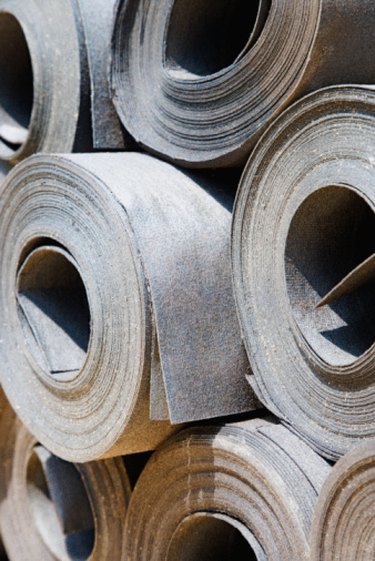
Rolled roofing represents a budget-friendly alternative to traditional roof tiles or shingles. Manufacturers make rolled roofing from many of the same materials used in asphalt shingles, including asphalt, tar and felt. Different types of rolled roofing may be used as an underlayment or flashing material, while others can serve as an effective roof finish on certain low-sloped roofing applications.
Smooth Finish
Video of the Day
Rolled roofing with a smooth finish consists of organic felt saturated with hot asphalt to give it a strong, stiff texture. Manufacturers often coat one or both sides of this material with a fine powder, such as talc or mica, which helps to prevent the roofing from sticking to the surrounding roof framing or finishes. Homeowners or contractors may install smooth finish rolled roofing to temporarily protect a building from moisture infiltration during a repair or remodeling scenario.
Video of the Day
This material may also be used on low-slope outbuildings, such as barns and sheds. In general, smooth finish rolled roofing offers little durability, and may be subject to leaks or tears over time.
Mineral Finish
Rolled roofing with a mineral finish offers a much higher level of strength and durability than smooth finish options. Manufacturers produce this material using fiberglass or organic roofing felt. The felt is then saturated with hot asphalt, then immediately coated with granules of mineral or rock. These granules embed themselves into the surface of the roofing, while the underside may be coated with talc to prevent sticking.
This material serves as a widely-used roof finish for barns, sheds and other outbuildings. Unlike other types of rolled roofing, it can be used alone over an extended period, and offers a high degree of protection against moisture. When used as a permanent roofing application, this material may be applied in overlapping rows, or even double layers to further enhance performance.
Saturated Felt
Saturated felt serves as an underlayment product for other roofing materials, and is not designed to serve as a roof finish material on its own. Made from roof felt saturated with asphalt, this material should be installed between the roof deck and shingles or tiles. It may also serve as a base layer for mineral coated rolled roofing.
Eaves Flashing
Rolled roofing designed for flashing can be distinguished from other types of rolled roofing in that it is generally self-adhesive. Installers use this material to enhance moisture protection around eaves, roof penetrations or any areas subject to pooling or ice dams. It may be used as an underlayment, or installed over an existing roof finish to serve as a patch until a leak can be repaired. Unlike other types of rolled roofing, eaves flashing often incorporates artificial polymers or additives in addition to traditional asphalt.